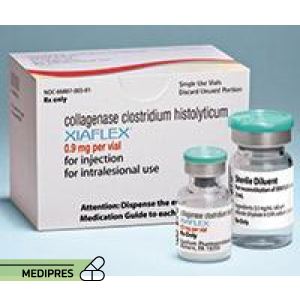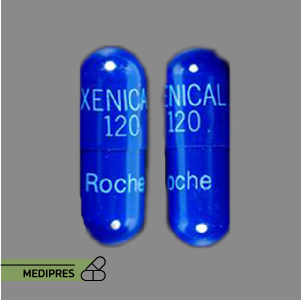
Xermelo
23 June, 2023
Xofluza
23 June, 2023Xiaflex
Generic name:
Collagenase clostridium histolyticum
Drug class:
Enzymatic therapy (collagenase)
Dosage form:
Lyophilized powder for reconstitution; single-use vials
Root of administration:
Intralesional injection
Dose:
Dupuytren contracture: 0.58 mg per injection per cord; up to 3 injections per 30-day cycle; maximum 3 cycles.
Peyronie’s disease: 0.58 mg per injection; two injections per cycle 1–3 days apart; up to 4 cycles with at least 6 weeks between cycles.
Varies by indication; consult label.
Mechanism of action:
Specific collagenases (AUX-I and AUX-II) hydrolyze type I and III collagen, cleaving the fibrous cords in Dupuytren contracture or plaques in Peyronie’s disease, thereby reducing contracture and curvature.
Drug usage cases:
- Dupuytren contracture with palpable cord(s) causing finger contracture
- Peyronie’s disease with stable penile curvature and palpable plaque
- Off-label: Ledderhose disease (plantar fibromatosis)
- Off-label: Frozen shoulder (adhesive capsulitis)
- Off-label: Other superficial fibrotic disorders
Drug contra indications:
- Hypersensitivity to collagenase or any excipient
- Infection at the injection site (e.g., cellulitis)
- Open wounds or ulcers in the treatment area
- Known bleeding diathesis or concurrent anticoagulant therapy
- Neuromuscular disorders affecting the hand or penis
- Peyronie’s disease with calcified plaques
Side effects:
- Injection site hemorrhage
- Swelling, pain, bruising, edema
- Injection site reactions (redness, tenderness, pruritus)
- Lymphadenopathy
- Muscle spasms (Dupuytren contracture)
- Painful erection, penile swelling, hematoma (Peyronie’s disease)
- Allergic reactions, including anaphylaxis
- Tendon or ligament rupture
- Neuropraxia or nerve injury
- Rash, urticaria
Warnings:
- Anaphylaxis and serious allergic reactions; ensure emergency medications and equipment are available
- Tendon rupture or ligament injury; assess risk and counsel patients to limit use of the treated area after injection
- Injection site hemorrhage and hematoma; apply firm pressure post-injection
- Peyronie’s disease: risk of penile fracture; advise sexual abstinence until healing
- Avoid injecting near neurovascular structures to prevent nerve injury
- Monitor for hypersensitivity; discontinue if severe reaction occurs
- Use aseptic technique to minimize infection risk
Use during pregnancy or breastfeeding:
Pregnancy: Animal studies have not demonstrated adverse fetal effects, but no adequate human studies exist. Use only if the potential benefit justifies the potential risk to the fetus.
Breastfeeding: It is unknown whether collagenase is excreted in human milk. Consider discontinuing breastfeeding or the drug, taking into account the importance of treatment to the mother.



